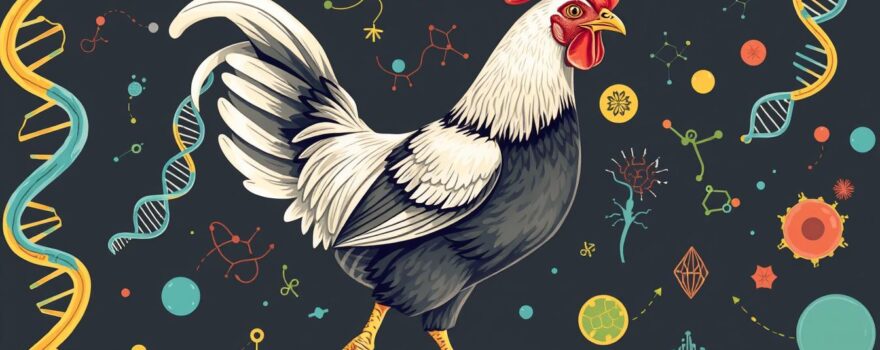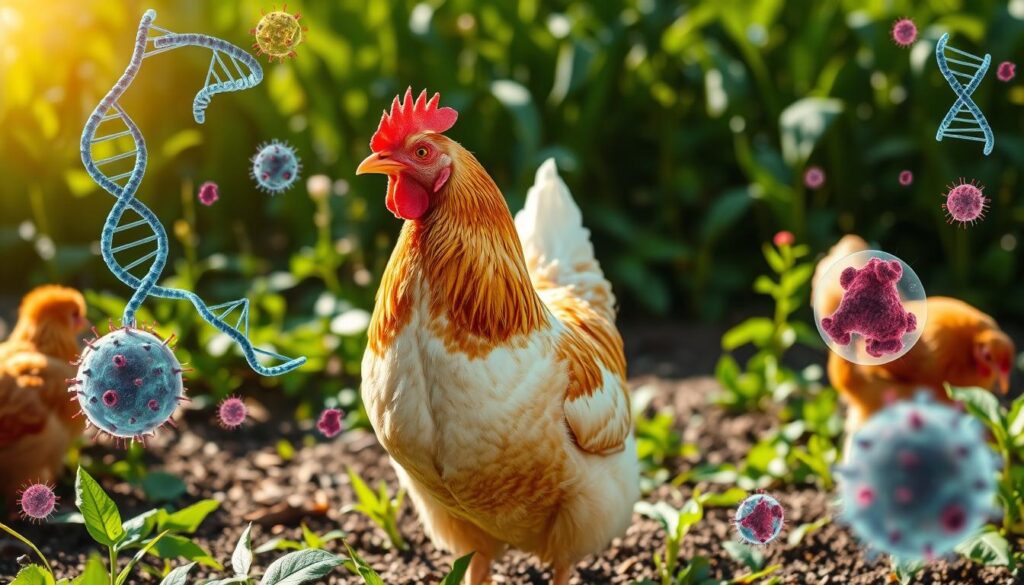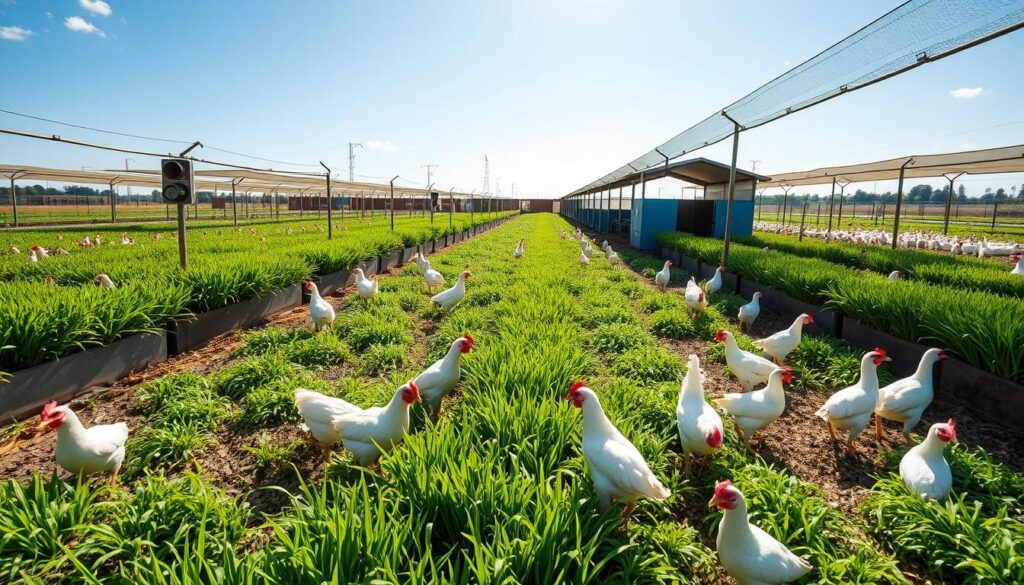
The broiler chicken industry has made huge strides in genetic selection. This has led to better productivity and efficiency. Over the last 20 years, breeding companies have focused on traits like body weight and growth rate.
Now, broilers are expected to reach 2.34 kg (5 lb) in under 29 days by 2034. But, this intense focus on production traits has harmed their immune system and disease resistance.
Genetic selection has greatly improved the poultry industry’s efficiency. It has helped meet the world’s growing demand for chicken meat. Yet, this focus on production has raised worries about the health and welfare of broiler chickens.
Introduction to Genetic Selection in Broiler Chickens
Genetic selection has been key in the broiler industry, making up 80 to 90% of production gains. Since the 1940s, breeding companies have used population genetics to boost productivity. Today, breeding companies have a pyramidal structure, with elite stock at the top and broilers at the base.
Importance of Genetic Selection in Broiler Production
After World War II, breeding programs for meat-type chickens grew fast. These programs were based on early 20th-century genetics. Today, broilers grow faster and need less food than before, showing big progress.
Objectives and Scope of the Article
This article will look at how genetic selection affects broiler chicken health and growth. It will cover the good and bad sides of modern breeding. We’ll also talk about how it impacts the immune system, disease resistance, and overall health.
It will also discuss the economic and welfare aspects of genetic selection. Plus, the importance of keeping genetic diversity in broiler breeding.
“Advances in genetic understanding have the potential to improve breeding programs for chickens, increasing production efficiency and optimizing welfare by enhancing resistance to stress and disease.”
Breeding Pyramid and Selection Process
The broiler chicken genetics breeding companies use a pyramid structure. At the top, a small group of elite stock exists. The base holds the larger broiler population. It takes about 4 years to move from pureline to meat-type birds.
A report shows that 400,000 pedigree birds from 35 to 40 purelines help supply billions of broilers. This shows the scale of the industry.
The Broiler Breeding Pyramid Structure
Breeding companies focus on growth rate, meat yield, and feed efficiency in male lines. Female lines emphasize growth rate, meat yield, egg production, and feed efficiency. Over 20 years, they’ve also focused on breast meat yield, increasing eviscerated yield.
Genetic Selection Methods and Timeframes
It takes about 4 years to introduce new chicken breeds or lines to the market. Livestock breeders have used artificial selection for thousands of years to create animals with desired traits.
Advances in selective breeding in poultry include the “Selection Index” method and mixed model equations. These have led to genomic selection with high-density SNP chips.
| Genetic Selection Advancement | Impact |
|---|---|
| Hazel (1943) introduced the “Selection Index” method | Improved breeding value estimation |
| Henderson (1950) developed mixed model equations | Enabled integrating information from all relatives into breeding value assessment |
| Genomic selection evolution | Led to high-density SNP chips, from 6,000 SNP to 600,000 SNPs, and tens of thousands genotyped birds |
“A one-gram egg weight change can yield 29 extra tons of eggs due to genetic progress in pure lines.”
These advancements have greatly improved poultry health management and broiler chicken welfare. They’ve also boosted broiler growth rate impact and genetic resistance to diseases. This has positively impacted the poultry industry sustainability.
Impact on Immune System and Disease Resistance
Genetic selection has greatly improved broiler chickens in terms of productivity and efficiency. However, it has also affected their immune system and disease resistance. Studies show that focusing too much on production traits can harm their immune genes.
This can lead to less genetic variation in immune-related genes. As a result, broiler chickens may become more susceptible to diseases. This is a big challenge for poultry health management and the welfare of broiler chickens.
“Immunocompetence and viability of broiler groups showed variations in growth rates and antibody responses to Escherichia coli vaccine as per research from Poult Sci in 2000.”
The effect of genetic selection on broiler chickens‘ immune system and disease resistance is a major concern. It’s important to find a balance between production traits and strong immune capabilities. This balance is crucial for the health and well-being of these birds and the future of the poultry industry.

The Impact of Genetic Selection on Broiler Chicken Health
The genetic selection for fast growth and high meat yield has harmed broiler chicken health. Research shows that these traits can weaken their immune system and make them more prone to diseases.
Choosing for fast growth might take away from the resources needed for a strong immune system. For example, Dutch farms using fast-growing broilers used 9 times more antibiotics in 2022 than those with slower-growing breeds.
| Trait | Faster-Growing Breeds | Slower-Growing Breeds |
|---|---|---|
| Carcass Yield | 69.9% | 70.4% |
| Wing Fat Yield | 14.0% | 15.6% |
| Breast Yield | 26.7% | 25.3% |
Faster-growing breeds might have more breast meat, but they have less carcass and wing fat. This shows the trade-offs in breeding for high productivity and chicken health.
“Between 1960 and 2004, the consumer price index for poultry products in the US increased at half the rate of all other products.”
Genetic selection’s effect on broiler chicken health is a big concern. It’s important to find a balance to protect these animals while still providing affordable poultry products.
Broiler Production Trends and Economic Aspects
The broiler chicken industry has seen big changes in how much they grow and how efficient they are. In 1957, a 42-day-old broiler weighed 586 g and needed 2.8 times its weight in feed. Now, a broiler of the same age weighs 2,900 g and uses less than 1.70 times its weight in feed. This big jump in growth and feed use is thanks to better genetics, making up about 80 to 90% of the gains.
Increase in Broiler Productivity and Efficiency
Genetic selection has been key to the industry’s growth. By 2034, broilers will be ready for market in less than 29 days, weighing 2.34 kg (5 lb). This shows the industry’s ongoing effort to get better and more efficient. It has also led to more people eating chicken, with a big jump in chicken meat consumption worldwide from 1995 to 2005.
Consumer Preferences and Market Demands
Changes in what people want to eat have also shaped the broiler industry. Fewer broilers are sold whole, and more are cut up or processed. In 1962, 83% of broilers were sold whole, but by 2009, only 12% were. More people want chicken in pieces or processed forms, leading to a focus on breast meat yield in breeding.
| Year | Whole Carcass | Cut-up Birds/Pieces | Further Processed |
|---|---|---|---|
| 1962 | 83% | 15% | 2% |
| 2009 | 12% | 42% | 46% |
“Genetic improvement accounts for approximately 80 to 90% of the production improvements observed in the broiler industry today.”
Welfare Implications of Genetic Selection
The push to make broiler chickens more productive through genetic selection has raised big worries. While breeding companies are trying to add welfare traits to their selection, there’s a need to find a better balance. This balance is between increasing production and making sure broiler chickens are well-treated.
Welfare Traits and Monitoring Indicators
It’s key to watch the welfare of broilers at every stage, from selection to slaughter. Breeding companies can tackle these welfare issues by using the right welfare indicators in their selection. Important welfare traits include:
- Locomotion and Skeletal Health: Keeping an eye on leg disorders, lameness, and other musculoskeletal issues. These can hurt the birds’ ability to move and feel comfortable.
- Metabolic and Cardiovascular Health: Checking for conditions like ascites, sudden death syndrome, and heart problems. These can harm the birds’ health and happiness.
- Behavioral Indicators: Watching how the birds behave, like foraging, dust-bathing, and socializing. This helps make sure their needs are met.
- Physiological Markers: Monitoring stress levels, immune function, and other health signs. These can show how well the broilers are doing overall.
By focusing on these welfare traits and monitoring indicators, breeding companies can aim for a better balance. This balance is between making broiler chickens more productive and ensuring they are treated well.
Balancing Production Traits and Welfare
Finding a balance between production traits and welfare in broiler chickens is a big challenge. Breeding companies must choose between improving traits like growth rate and meat yield. They also need to focus on the health and happiness of the birds.
This balance needs a deep understanding of genetics, nutrition, management, and the environment. Breeders must develop strategies that boost productivity and keep animal welfare high. Managing health issues like muscle myopathies is key to both meat quality and bird welfare.
Genomics and DNA analysis have been crucial in this effort. They help breeders predict genetic potential and choose the right traits. Working with scientists has also led to research on disease resistance, flock performance, and behavior. This research guides the selection process.
As consumers want more ethical and sustainable poultry, the industry must keep improving. Balancing market demands with broiler chicken welfare is vital for the future of the poultry industry.
“Genetic selection for improved health, welfare, and performance traits is a pivotal responsibility for poultry genetics companies.”
Maintaining Genetic Diversity in Broiler Breeding
Genetic diversity is key for the broiler chicken industry’s long-term success. But, focusing too much on breeding for production has reduced diversity. This can make broilers more prone to diseases and less adaptable to new environments.
To ensure the industry’s future, it’s vital to keep genetic diversity in broiler populations. Breeding companies and national efforts must work together. They need to maintain a wide genetic base. This will help the industry improve production and face new challenges.
Importance of Genetic Diversity Conservation
Genetic diversity is essential for improving broiler chickens. It lets breeders access a wide range of genetic variations. This is crucial for selecting desirable traits and meeting changing market needs. Without enough diversity, the industry can’t handle future challenges well.
Studies show how important genetic diversity is. A study on French local chicken breeds found high levels of genetic diversity. This highlights the value of these breeds as genetic reservoirs. Commercial broiler lines also lack rare alleles compared to their ancestors, showing the need for diversity conservation.
Managing traditional local poultry is critical. These populations are small, prone to inbreeding, and at risk of genetic drift. To keep diversity, initiatives like pedigree recording and optimized mating plans are used. These efforts help maintain genetic diversity in French breeds, offering lessons for the broader industry.
By focusing on genetic diversity, the broiler industry can become more resilient and adaptable. This will help it meet the changing needs of the poultry market and face future challenges.
Regional and National Initiatives for Broiler Welfare
The European Union (EU) has made some rules for broiler chicken welfare. But, there are also local and national efforts to help these birds. These efforts come from governments, industry groups, and others. They aim to check on broiler welfare, improve practices, and support better treatment in the whole production process.
A study looked at broiler welfare in five European countries. It found Sweden had the highest standards because of its strict laws. The Netherlands did well in meeting consumer demand for better chicken, thanks to market efforts and laws.
The EU Broiler Directive was agreed on in 2007. It sets rules for broiler production, like how much space they need and how much light they get. But, countries like Sweden have even stricter laws, leading to less local chicken production and more imports.
In the Netherlands, a big change happened. Retailers started selling only meat from chickens raised better. This made the market shift towards these “welfare” chickens. In places like Germany, Denmark, and the UK, there’s a fight between welfare-labeled and regular meat. This makes it hard for consumers to choose and affects prices.
The benchmark method helps compare how well laws and market efforts help broiler welfare. It looks at how well animals are treated, what experts say, and scores for welfare efforts. It rates from 0 to 100, showing how well animals are cared for.

“The benchmark method is a valuable tool in evaluating the effectiveness of regional and national initiatives in improving broiler chicken welfare.”
Impacts on Trade and Competitiveness
The broiler breeding and production industry sees a lot of trade. This trade happens both within the EU and with countries like the USA and Canada. The big players in the EU and worldwide have a big say in how competitive the industry is.
Trade Flows and Market Shares of Breeding Companies
Changes in chicken genetics and selective breeding in poultry can change how trade works. They also affect how EU companies compare to others globally. The poultry industry sustainability is linked to these trade patterns and market shares.
| Country | Poultry Meat Production (million tonnes) | Market Share |
|---|---|---|
| United States | 18.26 | 35.8% |
| China | 13.75 | 27.0% |
| Brazil | 12.69 | 24.8% |
| European Union | 11.37 | 22.3% |
| India | 3.56 | 7.0% |
The table shows the top countries in poultry meat production and their market shares. Knowing these trade flows and market shares helps us see how competitive the broiler industry is. This is especially true with the changes in broiler chicken genetics and selective breeding in poultry.
Genetic selection has greatly improved broiler chicken genetics and selective breeding in poultry over the years. Yet, this focus has also harmed poultry health management and broiler chicken welfare. Issues like weakened immune systems and less disease resistance have arisen.
It’s a big challenge to balance economic gains with animal welfare. The industry must find a way to do this.
To keep the poultry industry sustainable, we need to focus on genetic diversity in broilers. We must also improve welfare and breed for both growth and health. Research, teamwork, and support from policies are key to solving these problems.
This way, the broiler sector can grow responsibly. It will also ensure the meat we eat is of high quality and ethically produced.
The journey of genetic selection in broiler chickens has been impressive. But it shows we need a more complete approach. We must consider both efficiency and animal welfare.
By finding the right balance, the poultry industry can keep growing. It will meet the world’s demand for quality broiler meat responsibly.